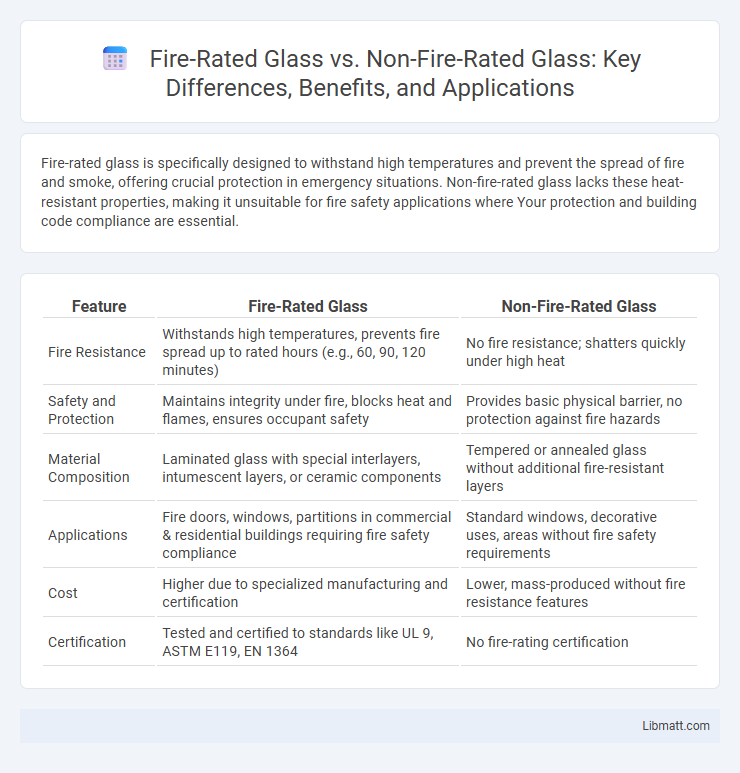Fire-rated glass is specifically designed to withstand high temperatures and prevent the spread of fire and smoke, offering crucial protection in emergency situations. Non-fire-rated glass lacks these heat-resistant properties, making it unsuitable for fire safety applications where Your protection and building code compliance are essential.
Table of Comparison
| Feature | Fire-Rated Glass | Non-Fire-Rated Glass |
|---|---|---|
| Fire Resistance | Withstands high temperatures, prevents fire spread up to rated hours (e.g., 60, 90, 120 minutes) | No fire resistance; shatters quickly under high heat |
| Safety and Protection | Maintains integrity under fire, blocks heat and flames, ensures occupant safety | Provides basic physical barrier, no protection against fire hazards |
| Material Composition | Laminated glass with special interlayers, intumescent layers, or ceramic components | Tempered or annealed glass without additional fire-resistant layers |
| Applications | Fire doors, windows, partitions in commercial & residential buildings requiring fire safety compliance | Standard windows, decorative uses, areas without fire safety requirements |
| Cost | Higher due to specialized manufacturing and certification | Lower, mass-produced without fire resistance features |
| Certification | Tested and certified to standards like UL 9, ASTM E119, EN 1364 | No fire-rating certification |
Introduction to Fire-Rated and Non-Fire-Rated Glass
Fire-rated glass is specifically engineered to withstand high temperatures and prevent the spread of flames and smoke, making it essential for safety in buildings requiring fire resistance. Non-fire-rated glass lacks these protective properties and cannot provide the same level of fire separation or structural integrity during a fire event. Your choice between fire-rated and non-fire-rated glass impacts building safety compliance and occupant protection.
Overview of Fire-Rated Glass Technology
Fire-rated glass is specially engineered with multiple layers or intumescent interlayers that expand when exposed to high temperatures, providing crucial fire resistance and preventing the spread of flames and smoke. Unlike non-fire-rated glass, which lacks these protective properties and shatters easily under heat, fire-rated glass maintains structural integrity during a fire event to safeguard your building and occupants. Utilizing fire-rated glass technology enhances safety standards in commercial and residential spaces by combining transparency with fire protection.
Key Features of Non-Fire-Rated Glass
Non-fire-rated glass primarily offers standard transparency and aesthetic appeal without the ability to withstand high temperatures or block flames during a fire. It lacks thermal protection and does not provide the necessary barriers to smoke or heat, making it unsuitable for fire safety applications. Your choice of glass should reflect the specific safety requirements of your building, especially in environments where fire resistance is critical.
Fire Resistance Standards and Certifications
Fire-rated glass complies with stringent fire resistance standards such as UL 9, ASTM E119, and BS 476, which measure its ability to withstand high temperatures and prevent the spread of flames and smoke for a designated period. Non-fire-rated glass lacks these certifications and fails to provide adequate protection during a fire, posing safety risks in commercial and residential buildings. Choosing fire-rated glass ensures compliance with building codes and enhances occupant safety by meeting recognized fire resistance performance criteria.
Performance Comparison: Fire-Rated vs Non-Fire-Rated Glass
Fire-rated glass offers enhanced thermal resistance, allowing it to withstand high temperatures and prevent fire spread for specified durations, typically ranging from 20 minutes to 120 minutes. Non-fire-rated glass lacks this specialized composition, making it prone to shattering and failing to provide a barrier during a fire event. The performance difference is critical in safety applications, with fire-rated glass maintaining integrity under intense heat, while non-fire-rated glass compromises structural safety and fire containment.
Applications and Use Cases in Building Design
Fire-rated glass is essential in building design for applications requiring enhanced fire safety, such as stairwells, corridors, and elevator shafts, where it helps contain fire and smoke while maintaining visibility. Non-fire-rated glass is typically used in areas without stringent fire protection requirements, like office partitions or storefronts, where aesthetics and transparency are prioritized over fire resistance. Choosing fire-rated glass for critical egress routes and fire barriers ensures compliance with building codes and enhances occupant safety.
Safety and Security Considerations
Fire-rated glass provides enhanced safety by withstanding high temperatures and preventing the spread of flames and smoke, crucial in emergency situations. Non-fire-rated glass lacks this capability, increasing vulnerability to fire damage and compromising building security. Utilizing fire-rated glass in construction improves occupant protection and helps meet stringent fire safety codes and insurance requirements.
Aesthetic Differences and Design Flexibility
Fire-rated glass offers designers distinct aesthetic advantages with its ability to maintain clarity and transparency while meeting stringent fire safety standards, allowing your spaces to remain visually open without compromising protection. Unlike non-fire-rated glass, which may lack the specialized laminates or coatings required for fire resistance, fire-rated glass supports innovative architectural elements such as large panels and seamless glazing systems. This design flexibility ensures that safety integrates seamlessly with modern aesthetics, making fire-rated glass an essential choice for projects demanding both beauty and functionality.
Cost Analysis: Fire-Rated vs Non-Fire-Rated Glass
Fire-rated glass typically costs 2 to 3 times more than non-fire-rated glass due to its specialized materials and manufacturing processes designed to withstand high temperatures and prevent fire spread. While the upfront investment is higher, fire-rated glass can significantly reduce potential property damage and improve safety compliance, ultimately saving on insurance premiums and costly fire repairs. Your choice should weigh immediate expenses against long-term benefits in safety and regulatory adherence.
Choosing the Right Glass for Your Project
Fire-rated glass offers enhanced safety features by withstanding high temperatures and preventing the spread of fire for a specified duration, making it essential for building code compliance and occupant protection. Non-fire-rated glass lacks these protective properties and is more suitable for aesthetic applications or areas without stringent fire safety requirements. Evaluating your project's safety needs and local regulations helps determine whether fire-rated glass is necessary to safeguard lives and property effectively.
Fire-rated glass vs non-fire-rated glass Infographic

 libmatt.com
libmatt.com